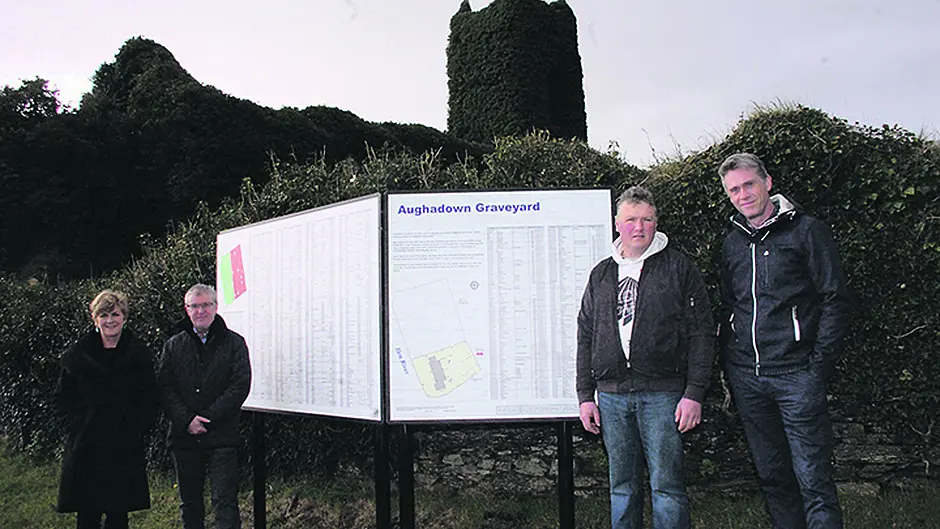The West Cork Graveyard Project is uncovering some interesting stories based on the historic characters buried in our local graveyards. Signs were recently erected at three more locations
The West Cork Graveyard Project is uncovering some interesting stories based on the historic characters buried in our local graveyards. Signs were recently erected at three more locations
INFORMATION on two important historic graveyards is now detailed on site at Aughadown and Drinagh graveyards. Two new signs list those known to be interred in these burial grounds as well as giving historical information on these medieval sites.
These signs are the third phase of the West Cork Graveyard Project which surveyed a dozen historic graveyards in this area. Signs have already been erected at Creagh, Abbeymahon and Chapel Lane graveyards and it is hoped that other graveyard signs will be erected over time.
Aughadown graveyard is divided into two sections with the eastern section containing a ruin of St Matthew’s Church, built in 1812. The western section, the older part, was the site of a church which was in use from at least late medieval times up to the early 1800s, however no trace of this building remains today.
The graveyard at Aughadown has been in use for centuries. It contains numerous graves and crypts with the earliest inscriptions dating to the early 1700s. The graveyard contains graves of members of Roman Catholic, Church of Ireland and Methodist churches. Many of the plots have been in families for generations and, as a result, the graveyard contains burials of people from a large hinterland. Stone slabs cover many of the graves and were brought to the graveyard from the homeplaces of the deceased, some of them brought in from the islands.
There are many people of interest interred at Aughadown including Patrick McCarthy of the 5th Cork Brigade of the IRA who took part in the Kilmichael Ambush in 1920. McCarthy was shot during the Siege of Skibbereen on the 4th of July 1922 at age 22. It was said that a lit cigarette marked his location for the shooter and a plaque now stands at the spot where he was killed on the Windmill Rock in Skibbereen.
Very close to the Patrick McCarthy grave is the tomb is of the Bechers of Aughdown, major landlords in the area. Buried in this plot is Colonel Thomas Becher who died in 1708 and served as aide-de-camp to King William of Orange at the Battle of the Boyne in 1690.
Jasper Wood-Wolfe, a Skibbereen solicitor who served as a TD for West Cork in the 1930s, is also buried at Aughadown as are many of the Pyburn family of Mohonagh and Heir Island, well known boat builders in the area.
Aughadown is also the final resting place of Dr Stephen Sweetnam. As a dispensary doctor during the Great Famine, Dr Sweetnam was very active in Famine relief in this area. A Famine landlord, Lionel Fleming of New Court, is also buried at Aughadown.
The old graveyard at Drinagh west was once the site of late medieval (and possibly even earlier) church which was in use up to the early 1800s, however nothing remains of it today. The existing ruin is from a later Church of Ireland church built in 1818. This is referred to locally as ‘the steeple’.
Drinagh West graveyard has been in use for several centuries and contains numerous Roman Catholic burials in unmarked graves with the earliest grave inscription dating to 1843. Just one grave is believed to be a Church of Ireland burial and this tomb is located inside the gate to the left. There was also a watch-house on this site, located in the corner on the left inside the entrance gate, which was used to prevent bodysnatching. Cadavers were once stolen and sold to anatomy schools and so relatives kept guard in these watch-houses until the bodies of their loved ones were no longer fresh enough for the surgeons.
The signs at all the graveyards are proudly supported by Cork County Council and put together by a group of volunteers, Barry McMahon, William Casey and Margaret Murphy alongside Terri Kearney of Skibbereen Heritage Centre and Mac Dara O h-Icí of Cork County Council.
Terri said: ‘We have had many visitors at Skibbereen Heritage Centre who have said that they found their ancestors’ grave on our website before deciding to come to Ireland. For many of them, this is the only tangible link to their ancestry and is therefore very precious to them. But we have had a fantastic response locally, too, as many people came forward with more information on those interred in these graveyards. We are honoured to record this information and make it available.’
The public can visit these historic sites in Skibbereen to see the new signs, or access the survey online at www.skibbheritage.com.
----








